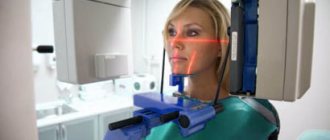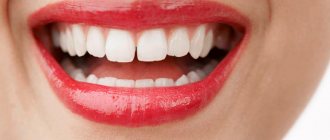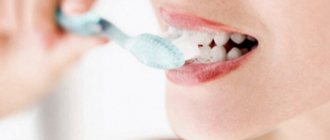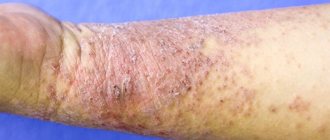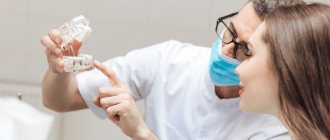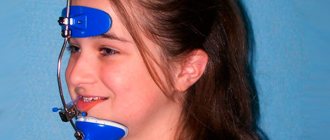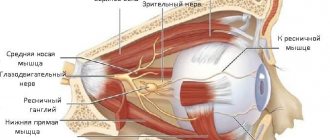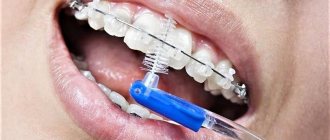2473
Temporomandibular joint dysfunction is a rather complex condition that can be experienced by people of different ages and health conditions.
A large number of different symptoms, difficulties with chewing and opening the mouth are a serious reason to visit the dentist to determine whether a pathology of the lower jaw joint, such as Costen syndrome, is developing.
Description of the problem
Costen's syndrome was discovered in the thirties of the 20th century. Otolaryngologist D. Kosten compared cases of patients complaining of ear pain due to pathologies in the structure of the jaw system, and came to the conclusion that there is a relationship between these factors.
Pathological occlusion syndrome, as Costen's syndrome is otherwise called, is a functional disorder of the temporomandibular joint.
This pathology affects the cartilage disc, which provides joint mobility in three directions, due to which complete chewing of food is carried out.
An unevenly distributed load between the jaws leads to inflammation of the cartilage disc, which can lead to its degeneration if not treated in a timely manner.
As a result of this phenomenon, there is a decrease or complete loss of mobility of the mandibular joint.
Reasons for development
Dentists still have not agreed on what can trigger the development of the syndrome.
The most common factors contributing to the development of the disease are the following:
- incorrect design of the denture, causing uneven distribution of load during chewing;
- various jaw injuries;
- congenital or acquired pathological bite;
- excessively strong one-time or constant loads on the jaw joint;
- bruxism;
- collagen diseases.
The development of Costen syndrome can be caused by a combination of several factors or by one of the above reasons.
If you find any problems in the operation of the dentition, you should consult a dentist.
How can a pacifier affect a child’s bite, tips for selection and use.
Read here all the most important things about the small vestibule of the oral cavity.
At this address https://orto-info.ru/zubocheliustnye-anomalii/chelyustey/krivaya-ne-prigovor.html we will talk about methods for correcting a crooked jaw.
Causes of the syndrome
There are many factors for the development of the syndrome. The main reasons are considered to be:
- absence of a large number of teeth;
- medical error by a dentist during prosthetics and fillings;
- overstrain of the masticatory muscles;
- untreated teeth grinding;
- disorders of mineral metabolism;
- infection;
- collagenoses;
- dental pathologies, due to which the load is distributed unevenly;
- malocclusion.
The syndrome can be caused by a combination of several of these factors, or by any one individually. In addition, there are risk factors that make the development of the disease more likely. These include:
- age over 50 years;
- menopause;
- jaw injuries;
- chronic inflammatory processes in the jaw area;
- osteoarthritis;
- hereditary tendency.
People at risk should be aware of the symptoms and treatment of Costen syndrome and its impact on the temporomandibular joint.
Expert opinion
Ravcheeva Yulia Anatolyevna
General dentist
The syndrome is very similar in symptoms to acute otitis media and arthritis. But there is one main point for determining the syndrome - it is impossible to open your mouth wide. To prevent the development of this disease, it is necessary to regularly visit the dentist for dental treatment, prosthetics and bite correction.
Risk factors
Dentists note that most often the development of Costen syndrome is observed in patients over 50 years of age. As a rule, the likelihood of its occurrence is higher in women than in men.
People who have a history of the following problems also fall into the risk category:
- injuries of the temporomandibular joints;
- unresolved violation of the structure of the dentofacial rows;
- absence of the last molars in each row;
- osteoarthritis.
Some dentists suggest that genetic predisposition can also become a factor in the development of pathology, however, this assumption has not been proven.
Symptoms
Costen's syndrome is characterized by the presence of a collection of symptoms that are rarely interrelated.
In addition, in the initial stages of the disease, symptoms may not appear, which delays the patient’s visit to the dentist and complicates timely diagnosis.
Most often, patients experience the following signs of disease development:
- pathologies in the functioning of the temporomandibular joint - difficulties during opening and closing of the jaw, the appearance of crunching and clicking, severe pain during chewing;
- the appearance of dryness and acute pain in the root of the tongue and pharynx;
- the formation of a herpetic rash on the mucous membranes of the oral cavity and the outer edge of the ear canal;
- the occurrence of trigeminal neuralgia - severe pain of a paroxysmal nature that affects one side of the face - jaw, cheek, ear, eye;
- pain in the ears and head, which may worsen when sneezing or singing.
In some cases, patients may experience frequent dizziness, hearing loss, and pain in the cervical spine.
Material and methods
The work included data from the examination and treatment of 45 patients aged 23 to 54 years (42 women and 3 men) who sought help at NIKIO named after. L.I. Sverzhevsky and the Clinical Center for Maxillofacial, Reconstructive and Plastic Surgery of the Moscow State Medical University named after. A.I. Evdokimov.
Inclusion criteria: 1) age from 20 to 55 years; 2) complaints of pain in the ear/temple/lower jaw; 3) fullness/noise in the ear and/or dizziness; 4) pathological dental occlusion.
Non-inclusion criteria: 1) congenital and acquired anomalies of the cervical spine and facial skeleton, confirmed radiologically, with the exception of TMJ pathology; 2) decompensated somatic diseases; 3) other forms of CVS, confirmed by vestibulometric tests.
Along with a detailed history taking and detailing of complaints, neurological and ENT examinations, all patients underwent manual and osteopathic testing and instrumental diagnostics: radiography of the cervical spine with functional tests and cone-beam computed tomography of the facial skeleton, magnetic resonance imaging (MRI) of the TMJ, ultrasound examination of the arteries of the neck and head, audiometry and vestibulometry, MRI of the brain with assessment of the condition of the cerebellopontine angles. Manual and osteopathic examination was carried out according to generally accepted methods using methods of testing the muscular system and conducting provocative tests (jugular compression, chewing provocation test, etc.) [4, 5]. Kinesiological tests were carried out to determine the type of postural disorders and to identify the influence of the TMJ structures on the postural control system. Vertebral dysfunction was diagnosed in the presence of functional disorders in the spinal motion segments and facet joints.
Based on the survey data, ear noise [6] and dizziness [7] were assessed, taking 16 points as the upper limit of weak noise, audible only in silence, and 10 points as the upper limit of maladjustment associated with dizziness. Pain intensity was assessed using a 10-point visual analogue scale (VAS). The severity of personal and situational anxiety was assessed using the results of the Spielberger-Khanin test.
All patients were divided into three equal groups (n=15), comparable in age, gender, somatic and dental status. In each of the groups, therapy was carried out according to certain regimens. Patients of the 1st group received drug therapy for 1 month - non-steroidal anti-inflammatory drugs (NSAIDs) and muscle relaxants, if indicated - anxiolytics (aminophenylbutyric acid preparations for 1 month) and a course of osteopathic treatment consisting of 4-7 procedures carried out 1 —2 times a week, aimed at relaxing the masticatory and cervical muscles, eliminating ligamentous, articular, visceral and vertebral dysfunctions, taking into account the identified type of postural disorders. Patients of group 2 underwent splint therapy for 12 months, followed by orthodontic treatment to normalize the occlusion of the dentition. Splint therapy is a set of therapeutic measures aimed at stabilizing the lower jaw and relaxing muscles using a removable intraoral splint. Patients of group 3 received complex treatment, including methods used in groups 1 and 2.
The effectiveness of treatment was assessed according to clinical (regression of pain, dizziness, tinnitus; normalization of muscle tone, achievement of a stable position of the lower jaw and free opening of the mouth - according to manual and kinesiological testing) and hardware (MRI of the TMJ) criteria 3 months after completion of all treatment procedures in each group, i.e. 4 months from the start of treatment in group 1 and 15 months from the start of treatment in groups 2 and 3. All study participants signed informed consent before starting the study.
Statistical processing of the results was carried out using statistical software packages Statistica for Windows 6.0. With a normal distribution in the studied samples, parametric criteria were used. In the case of distribution of values in samples other than normal, the analysis of research results was carried out using non-parametric tests: comparison of two independent groups (Mann-Whitney test), comparison of two dependent groups (Wilcoxon-Mann-Whitney U test). Differences were considered significant at p<0.05.
Classification
During the development process, pathological bite syndrome goes through four stages, each of which is characterized by the following symptoms:
- First stage. The size of the joint space narrows unevenly, and slight loosening of the ligament apparatus is observed. A person begins to experience the first symptoms of a pathological change in the cartilage disc.
- Second stage. The mobility of the temporomandibular joint decreases, ossification occurs in the area of the condylar process of the mandible.
- Third stage. Degeneration of the cartilage disc continues, and sclerosis of the articular surfaces develops. Movement of the lower jaw is severely limited.
- Fourth stage. The patient experiences a strong proliferation of fibrous tissue, and the mobility of the lower jaw is completely absent.
A person experiences persistent pain in the jaw area, radiating to the ear or cheek. At this stage, treatment is carried out exclusively by surgical methods.
results
The duration of the disease until diagnosis ranged from 2 months to 16 years. Pain in the ear/temple/lower jaw area was characterized as aching, pressing and sometimes shooting, provoked by chewing or speech stress and relieved by NSAIDs or local thermal procedures. Congestion in the ear was position-dependent in 12 (27%) patients - 4 patients in each group; Position-dependent tinnitus was present in 3 (7%) patients in group 1 and 1 patient in group 3. Systemic dizziness occurred paroxysmally and was associated with the impact of the joint on the temporal bone or a myofascial trigger in the neck muscles, non-systemic, caused by asymmetric tone of the neck muscles, with head movement. A cracking sound in the ear and clicks in the TMJ (see table) during movement of the lower jaw were noted in all patients.
Complaints and objective symptoms of the examined patients before and after treatment
Note. * — differences are significant compared to groups 1 and 2 (p<0.05).
The triggering factor for the development of CVS in 24 (53%) patients was various dental procedures (extraction, restoration of teeth, installation of fillings, braces, crowns or implants), carried out in the period from 2 weeks to 6 months before the onset of the disease. A frequent trigger for CVS was an acute psychotraumatic situation with a negative emotional background in the future (n=10; 22%).
Pathology of the inner or middle ear was not detected in any patient; 17 (38%) had unilateral or bilateral obstruction of the auditory tube. Hidden unilateral or bilateral asymmetrical spontaneous horizontal nystagmus was detected in 36 (80%) patients (see table) . The examination made it possible to register unilateral or bilateral asymmetric horizontal nystagmus in all patients. MRI of the brain revealed no focal changes in the vestibular nerves and nuclei, cerebellum and cerebellopontine angle.
A neurological examination did not reveal any motor or sensory disorders or dysfunction of the cranial nerves. All patients performed coordination tests confidently, however, in the Romberg test, 11 (24%) patients were unstable; during tests with head turns, instability was recorded in 17 (38%). Manual testing made it possible to identify pain triggers in the neck muscles and masticatory muscles in all patients (see table) , and triggers, the compression of which caused the appearance of ear noise, a change in its intensity or tone, dizziness of a systemic or non-systemic nature, were found in 21 (47%) and 27 (60%) of those examined, respectively. In 16 (36%) cases, an ascending or mixed type of postural dysfunction was determined, and therefore the patients underwent individual foot orthoses.
As a result of the course of treatment in group 1, there was a decrease in the intensity of the pain syndrome according to VAS, a decrease in the frequency of ear noise with unchanged intensity, dizziness and nystagmus, signs of TMJ dysfunction (all differences are significant, p <0.05) (see table) . All types of muscle triggers were inactivated, but the degree of maladjustment associated with dizziness and personal anxiety did not change significantly. Symptoms resumed after 1.5-2.5 months, which was apparently determined by the persisting pathological relationships of the elements of the TMJ and the occlusal discrepancy of the dentition.
In group 2, therapy led to a decrease in the intensity of pain (see table) , tinnitus and dizziness, signs of TMJ dysfunction, but to a lesser extent than in group 1. Painful muscle triggers persisted, as did tinnitus and dizziness triggers. Hidden spontaneous nystagmus was detected with the same frequency, while nystagmus during the head shaking test was recorded 2 times less often than before treatment. The degree of maladaptation, personal and situational anxiety remained almost at the original level. The achievement of the effect was hampered by the preservation of hypertonicity of the masticatory muscles.
Combined treatment in the 3rd group made it possible to achieve significant results that differed significantly not only from the initial level, but also from the final indicators in the 1st and 2nd groups (see table) : in all 15 patients, facial and parotid pain were relieved and dizziness, spontaneous nystagmus regressed, all types of triggers in the masticatory muscles were completely inactivated. Only 1 patient retained tinnitus (less intense than before treatment) and nystagmus during the head shaking test; in this case, signs of TMJ dysfunction remained. The degree of maladjustment associated with dizziness and situational anxiety decreased to normal values (p<0.05).
According to the control MRI of the TMJ, no changes in the condition of the TMJ were recorded in group 1. In group 2, complete restoration of the relationships of the articular structures was achieved in 3 (20%) cases, partial - in 8 (53%); and only in the 3rd group the full effect was achieved in 14 (93%) patients.
Consequences
Lack of treatment in the initial stages of the disease can lead to a significant deterioration of the situation, increased pain and decreased mobility of the temporomandibular joint.
Among the common complications of Costen syndrome, the most common conditions are:
- Indigestion. Due to limited mobility of the jaw joint and severe pain that accompanies the chewing process, grinding hard foods in the oral cavity is noticeably impaired. This entails an increased load on the organs of the gastrointestinal tract.
- Weakening of the ligamentous apparatus. As a result of this phenomenon, a fairly free exit of the head of the lower jaw from the articular fossa occurs.
- Accumulation of inflammatory exudate in the joint cavity. An excessive amount of fluid in the joint cavity contributes to a loose fit of the disc to the head. As a result, popping sounds occur when the jaw moves.
What is the problem
The joint connecting the lower jaw to the base of the skull is formed by the head of the mandibular bone and the fossa of the temporal bone, and is therefore called the temporomandibular joint. There is a disk inside it that divides the cavity into two sections. Thanks to it, the joint moves in three directions and performs the following functions:
- opening and closing the mouth (movement along the frontal axis);
- displacement of the lower jaw forward and backward (sagittal direction);
- lateral movements when chewing (vertical axis).
Although the extreme boundaries of the movements of the lower jaw are controlled by one major and two minor ligaments, when chewing food, speaking and facial expressions, too much load is placed on the joint. Because of this, it may stop performing its functions normally, and then various diseases develop. This may be arthritis, arthrosis, chronic subluxation of the lower jaw or myofacil syndrome, but otoneurological syndrome occurs more often.
The difference between a healthy joint and one affected by arthrosis
Diagnostics
To determine Costen's syndrome, the dentist must carry out a number of mandatory procedures, since the presence of a variety of symptoms often complicates the diagnosis:
- Examination of the patient and clarification of existing complaints.
- Phalangeal test to detect Costen's syndrome. The essence of the method is that in the absence of disease, during the opening of the oral cavity, the phalanges of three fingers should be located unhindered between the teeth of the opposite jaws.
If this is problematic and only two fingers fit into the gap formed, the dentist concludes that there is temporomandibular joint dysfunction. - Tympanometry of the ear. The examination allows us to identify the presence or absence of middle ear pathologies in order to correctly diagnose the disease.
- An X-ray examination is carried out to determine the condition of the dentition and the structural anomalies present in it.
- Consultation with relevant specialists. To exclude diseases with similar symptoms, an examination by an otolaryngologist, orthodontist, or neurologist may be required.
Indications for compactosteotomy and surgical technique.
In this publication, see photos of tooth protrusion.
Follow the link https://orto-info.ru/zubocheliustnye-anomalii/zubov/kolichestva/skuchennost-i-sposobyi-ustraneniya-problemyi.html if you are interested in methods for treating crowding of the lower row of teeth.
Main symptoms
The disease is not widely known, and not every textbook on dentistry contains its description. Nevertheless, this disease is very unpleasant and quite serious; it is better to know its symptoms in advance in order to consult a doctor in time. The following signs may indicate it:
- difficulty moving the jaw, especially when talking and eating;
- crunching sound when opening the mouth;
- burning pain and dryness in the throat and root of the tongue;
- discomfort in the jaw, neck, eyes and ear;
- herpes on the mucous membranes of the mouth and in the external auditory canal;
- trigeminal neuralgia;
- weakening of the velum;
- slight facial asymmetry;
- hearing loss;
- periodic dizziness.
Thus, there are quite a lot of symptoms, and they often seem unrelated. However, postponing a visit to the doctor threatens to worsen the pain and cause complications.
Typical complaints of patients during the development of pathology
Treatment
After making a diagnosis, the specialist makes a decision on the need for specific therapeutic measures.
Their complexity depends on the severity of the pathology, however, in any case, the patient must follow the following recommendations to help reduce the load on the jaw joint:
- Stick to a diet. It is necessary to stop eating hard foods and switch to soft and pureed foods. It is advisable that the basis of the diet be
cereals, purees, dairy products.
- Avoid prolonged socializing and chewing gum to reduce the impact on the jaw.
- Reduce stress levels in everyday life, since high nervous tension increases pain impulses.
- Sanitate the oral cavity to eliminate problems that may serve as aggravating factors.
Drug therapy
To eliminate the inflammatory process and relieve pain, specialists can prescribe the patient a complex of medications, which includes:
- Painkillers and anti-inflammatory drugs - Ibuprofen, Dexalgin, Brustan, Ketonal. The drugs have a high analgesic effect and reduce the manifestation of the inflammatory-degenerative process in the cartilage disc.
- Activators of metabolism in tissues - injections or Solcoseryl gel, tablets, ointment or Actovegin gel. Thanks to these drugs, the regenerative process is stimulated and tissue trophism is improved.
- Drugs from the muscle relaxant group help reduce the tone and tension of the jaw muscles and reduce the severity of muscle spasms. Most often, experts prescribe drugs such as Baklosan, Sirdalud, Tizanil.
- Multivitamin complexes – Neurodiclovit, Milgamma, Neurobion, Neuromultivit. Due to the high content of B vitamins in these preparations, pain in inflamed joints is relieved, the processes of creation and blood circulation are improved, and the functioning of the central nervous system is stabilized.
- Sedatives - Afobazol, Fabomotizol, Noofen, which reduce feelings of anxiety and tension, making the pain impulse less pronounced.
Physiotherapy
If a disease is detected at the initial stage, a set of physiotherapeutic procedures, which includes the following measures, may be sufficient to eliminate it:
- fluctuarization of the masticatory muscle area - the procedure has a relaxing and analgesic effect;
- electrophoresis of drugs allows you to increase their effectiveness in reducing pain, relaxing muscles and improving regenerative processes;
- diadynamic therapy - exposure to continuous pulsating current for several minutes produces a pronounced anesthetic effect and helps improve tissue trophism;
- UHF therapy , which is a general and local effect of an electric field, allows you to deeply and evenly heat the inflamed tissue, increasing the rate of its regeneration.
To increase the effectiveness of therapy, experts recommend combining physiotherapeutic procedures with massage of the jaw area, myogymnastic exercises, and acupuncture procedures.
In addition, the orthodontist may recommend the use of a special device that limits the degree of opening of the oral cavity, which reduces the load on the joints.
Surgery
The surgical method of eliminating Costen's syndrome is used at an advanced stage of the disease when other methods of therapy are ineffective.
Surgery is risky because there is a risk of severe bleeding, nerve damage, or scarring of the joint.
At the same time, surgery to remove elements of the temporomandibular joint, such as the cartilage disc or head, may be the only option to restore the proper functioning of the jaw.
In this case, in place of the removed elements, the specialist installs a graft, which allows you to restore proper contact and opening of the jaw rows, as well as establish a painless chewing process.
Price
The cost of eliminating Costen syndrome depends on the severity of the pathology and treatment methods:
| Procedure name | Cost of carrying out, rub. |
| Fluctuarization | 800—1700 |
| Electrophoresis | 900—2700 |
| Diadynamic therapy | 500—1500 |
| UHF therapy | 600—1500 |
| Acupuncture | 3 000—4 000 |
| Massage | 1 700—3 200 |
| Surgery (arthroplasty) | 55 000—100 000 |
The large difference in prices is explained by the location of the clinic, the professionalism of the staff and the average cost of similar services in different cities of the country.
Additional information about the temporal joint anomaly is presented in the video.

